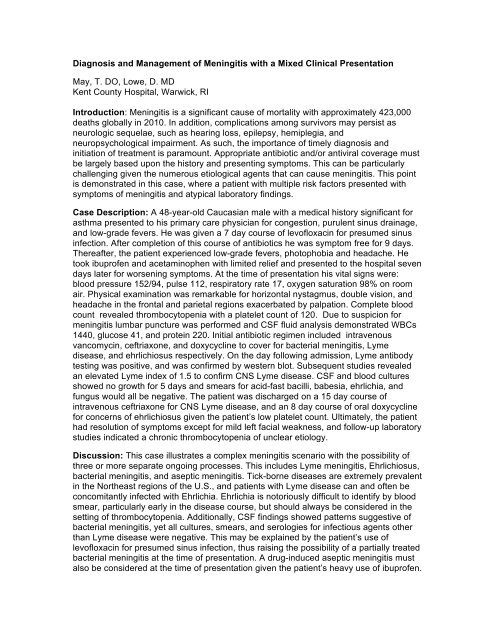Acute Flaccid Paralysis Accompanying West Nile Meningitis Ahmed ...
Acute Flaccid Paralysis Accompanying West Nile Meningitis Ahmed ...
Acute Flaccid Paralysis Accompanying West Nile Meningitis Ahmed ...
Create successful ePaper yourself
Turn your PDF publications into a flip-book with our unique Google optimized e-Paper software.
Diagnosis and Management of <strong>Meningitis</strong> with a Mixed Clinical Presentation<br />
May, T. DO, Lowe, D. MD<br />
Kent County Hospital, Warwick, RI<br />
Introduction: <strong>Meningitis</strong> is a significant cause of mortality with approximately 423,000<br />
deaths globally in 2010. In addition, complications among survivors may persist as<br />
neurologic sequelae, such as hearing loss, epilepsy, hemiplegia, and<br />
neuropsychological impairment. As such, the importance of timely diagnosis and<br />
initiation of treatment is paramount. Appropriate antibiotic and/or antiviral coverage must<br />
be largely based upon the history and presenting symptoms. This can be particularly<br />
challenging given the numerous etiological agents that can cause meningitis. This point<br />
is demonstrated in this case, where a patient with multiple risk factors presented with<br />
symptoms of meningitis and atypical laboratory findings.<br />
Case Description: A 48-year-old Caucasian male with a medical history significant for<br />
asthma presented to his primary care physician for congestion, purulent sinus drainage,<br />
and low-grade fevers. He was given a 7 day course of levofloxacin for presumed sinus<br />
infection. After completion of this course of antibiotics he was symptom free for 9 days.<br />
Thereafter, the patient experienced low-grade fevers, photophobia and headache. He<br />
took ibuprofen and acetaminophen with limited relief and presented to the hospital seven<br />
days later for worsening symptoms. At the time of presentation his vital signs were:<br />
blood pressure 152/94, pulse 112, respiratory rate 17, oxygen saturation 98% on room<br />
air. Physical examination was remarkable for horizontal nystagmus, double vision, and<br />
headache in the frontal and parietal regions exacerbated by palpation. Complete blood<br />
count revealed thrombocytopenia with a platelet count of 120. Due to suspicion for<br />
meningitis lumbar puncture was performed and CSF fluid analysis demonstrated WBCs<br />
1440, glucose 41, and protein 220. Initial antibiotic regimen included intravenous<br />
vancomycin, ceftriaxone, and doxycycline to cover for bacterial meningitis, Lyme<br />
disease, and ehrlichiosus respectively. On the day following admission, Lyme antibody<br />
testing was positive, and was confirmed by western blot. Subsequent studies revealed<br />
an elevated Lyme index of 1.5 to confirm CNS Lyme disease. CSF and blood cultures<br />
showed no growth for 5 days and smears for acid-fast bacilli, babesia, ehrlichia, and<br />
fungus would all be negative. The patient was discharged on a 15 day course of<br />
intravenous ceftriaxone for CNS Lyme disease, and an 8 day course of oral doxycycline<br />
for concerns of ehrlichiosus given the patient’s low platelet count. Ultimately, the patient<br />
had resolution of symptoms except for mild left facial weakness, and follow-up laboratory<br />
studies indicated a chronic thrombocytopenia of unclear etiology.<br />
Discussion: This case illustrates a complex meningitis scenario with the possibility of<br />
three or more separate ongoing processes. This includes Lyme meningitis, Ehrlichiosus,<br />
bacterial meningitis, and aseptic meningitis. Tick-borne diseases are extremely prevalent<br />
in the Northeast regions of the U.S., and patients with Lyme disease can and often be<br />
concomitantly infected with Ehrlichia. Ehrlichia is notoriously difficult to identify by blood<br />
smear, particularly early in the disease course, but should always be considered in the<br />
setting of thrombocytopenia. Additionally, CSF findings showed patterns suggestive of<br />
bacterial meningitis, yet all cultures, smears, and serologies for infectious agents other<br />
than Lyme disease were negative. This may be explained by the patient’s use of<br />
levofloxacin for presumed sinus infection, thus raising the possibility of a partially treated<br />
bacterial meningitis at the time of presentation. A drug-induced aseptic meningitis must<br />
also be considered at the time of presentation given the patient’s heavy use of ibuprofen.

















